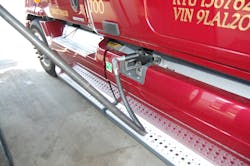Average retail pump prices for diesel and gasoline in the U.S. remained on a downward path this week, according to data tracked by the Energy Information Administration (EIA).
Diesel declined 1.9 cents this week to a national average of $3.894 per gallon, though that is 2.7 cents per gallon higher compared to the same week in 2013, the agency said.
Prices fell in all regions of the U.S., according to the EIA, with diesel exceeding the $4 per gallon in New England (down 2 cents to $4.078), the Central Atlantic (down 1.8 cents to $4.051), California (down 1.6 cents to $4.119), and the West Coast (down 1.5 cents to $4.052, though with California removed, prices dropped 1.4 cents to $3.971).
Diesel dropped the most this week in the Midwest, the agency pointed out – declining 2.5 cents to $3.837 per gallon – though the Gulf Coast remained home to the cheapest diesel in the country at $3.787 per gallon.
The national average for gasoline continued to fall this week, dropping 4.3 cents to $3.635 per gallon, though the EIA noted that’s only 4/10ths of a penny cheaper compared to the same week in 2013.
Gasoline prices only increase in one region this week, the agency said: the Rocky Mountains, where prices increased 2/10ths of a penny to $3.644 per gallon. Though gasoline declined 3.6 cents on the West Coast, prices remained above the $4 per gallon mark at $4.001 – though with California removed from the mix, West Coast gasoline prices dropped 3.3 cents to $3.848 per gallon.
The Midwest recorded the largest one-week decrease in gasoline prices according to EIA’s numbers – 7.5 cents to $3.539 per gallon – with the Central Atlantic running a very distant second with a 3.5 cent decline to $3.707. The home to the cheapest gasoline in the U.S. this week, though, is the Gulf Coast at $3.44 per gallon.
On a side note, analysis by EIA indicates that that recent improvements in light vehicle fuel economy may offer diminishing returns in fuel savings over time, especially as low fuel economy models are “aged out” of the overall vehicle pool.
For example, the agency calculation that switching from a 10-mile-per-gallon (mpg) vehicle to a 15-mpg vehicle saves more fuel and results in greater fuel cost savings versus switching from a 25-mpg vehicle to a 75-mpg vehicle. In short, the fuel and cost savings of improving fuel economy from 12 mpg to 15 mpg are the same as increasing from 30 mpg to 60 mpg.
The EIA added that much of the reduction in fuel consumption and fuel cost comes from incremental fuel economy improvement at the relatively low fuel economy levels. For a consumer who drives 12,000 miles per year and pays $3.50 per gallon for gasoline, increasing fuel economy from 10 mpg to 11 mpg saves $382 in annual fuel cost and from 30 mpg from 31 mpg saves $45, while raising fuel economy from 40 to 41 mpg saves just $26 and from 60 to 61 saves $11.
The agency did stress that vehicles using fuels other than gasoline, such as diesel or electricity, offer a different set of fuel savings and costs to consider.
Diesel vehicles often have higher fuel economy than standard gasoline vehicles, but they also must use diesel fuel, which is more expensive than gasoline. Meanwhile, plug-in electric vehicles that achieve high fuel efficiency and take advantage of relatively inexpensive electricity compared to gasoline can accrue significant fuel cost savings, yet at higher incremental vehicle cost.
As light-duty vehicle fuel economy continues to increase because of more stringent future greenhouse gas emission and Corporate Average Fuel Economy (CAFE) standards through model year 2025, standard gasoline vehicles are expected to achieve compliance fuel economy levels of around 50 mpg for passenger cars and around 40 mpg for light-duty trucks.
And even with those “diminishing returns” from improved fuel economy included, EIA believes more fuel-efficient gasoline-only vehicles are becoming more competitive options relative to other vehicle types such as diesels, hybrids, and plug-in vehicles – especially given the relatively higher vehicle prices projected for those other models.
About the Author
Sean Kilcarr
Editor in Chief
Sean Kilcarr is a former longtime FleetOwner senior editor who wrote for the publication from 2000 to 2018. He served as editor-in-chief from 2017 to 2018.
